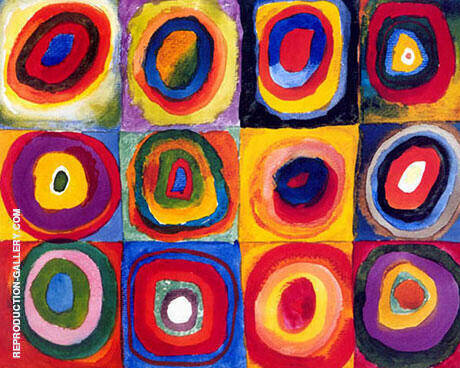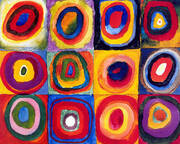Concentric Squares and Circles 1913 By Wassily Kandinsky
Kandinsky Concentric Circles painting titled “Quadrate mit konzentrischen Ringen” is a pioneering example of twentieth-century abstract art.
This famous Kandinsky painting is small in size but has a massive impact.
When did Kandinsky paint Squares with Concentric Circles?
Concentric Circles art by Kandinsky is the artist’s most recognizable painting, completed in 1913.
Despite this, it’s not a finished painting. Instead, it is a small study of color combinations and designs. Kandinsky often used similar tools as support material for his larger images.
Even so, it has become one of our most popular modern art oil paintings.
During his career, Wassily Kandinsky developed a unique and highly detailed color theory. He believed color caused the human soul to vibrate. For Kandinsky, color had a decisive influence on our bodies and nervous system. He even believed certain color combinations could cure disease.
Saying he could “hear colors” and “see sounds,” many Art Historians suggest Kandinsky experienced “synesthesia.” This term describes people who mix two senses at once.
Indeed, Wassily Kandinsky ar often has titles named after musical themes. These melodic creations included paintings such as Composition VIII (1923) and Improvisation (1914).
Why did Kandinsky paint Squares with Concentric Circles?
Kandinsky painted Squares with Concentric Circles as a study of color and form.
He created a grid-like composition, with four circles in the horizontal rows and three in the vertical columns. In each square unit, a concentric circle dominates the sIn addition, each. Each multi-colored halo has a deep, transfixing center.
This experiment reflects Kandinsky’s views on the importance of circles. These simple shapes symbolize the mysteries of the cosmos. They also provided a medium for Kandinsky’s exploration of color. In 1930, Kandinsky explained how his fascination with spheres stemmed from planetary orbs and motion.
In addition, Kandinsky believed the most foundational artistic mark, the dot (or point), was also a small circle. This simple fact meant that all art, of any form, arose from circles.
This painting revealed a significant shift in Kandinsky’s artwork, away from figurative representation and toward more extreme abstraction.
Kandinsky formed Der Blaue Reiter group in 1911 (two years before he painted Squares with Concentric Circles). The movement included painters such as Franz Marc, August Macke, and Alexej von Jawlensky. Together, these artists shared interests in bright colors, abstracted forms, and spiritual values in art.
What do Kandinsky circles mean?
In Wassily Kandinsky abstract art, circles represent ideal symmetry, balance, and harmony.
He felt these simple shapes brought order and symmetry to any artwork and featured them in many famous Kandinsky paintings.
Like many artists, Kandinsky believed modern art needed to express society’s utopian dreams. Consequently, geometric forms represented higher forms of intellectualism above day-to-day concerns. Of the three primary forms (the circle, square, and triangle), Kandinsky said the sphere pointed “most clearly” towards the fourth dimension.
Building on this early study, Kandinsky later produced a series of artworks exclusively focused on circles. Between 1923 and 1929, Kandinsky made ten paintings, including Circles within a Circle (1923) and Several Circles (1926).
Speaking of Circles within a Circle, Kandinsky said it was his first painting that truly brought “circles to the foreground”.
Where is Kandinsky Squares with Concentric Circles?
Concentric Circles by Kandinsky hangs in the Lenbachhaus Museum in Munich, Germany. Acquired with the help of the Gabriele Münter Foundation in 1957, it’s remained with the gallery ever since.
The gallery specializes in nineteenth-century art, particularly Der Blaue Reiter group. Indeed, the museum owns over 700 Kandinsky paintings and drawings.
Today, the painting remains one of our most desired art reproductions. As a bright, bold, and energetic work, it’s among our collection’s most prized famous painting replicas.
We offer a 100% money back guarantee or replacement service. If for any reason you are dissatisfied with your painting please contact us within 7 days of receipt, advising the reason you are unhappy and we will provide you with all the information you need for its return or replacement.
We ship free to anywhere in the world via FedEx or DHL expedited service with online tracking.
Your painting will be shipped rolled in strong plastic tubing, ready for stretching and/or framing locally. This is the conventional method of transporting hand-painted oil on canvas. Learn more about how your painting is shipped.
We are able to offer a framing service intercontinental U.S. Please contact us if you would like a quotation. Alternatively, should you prefer, we can recommend a framer in your area.
Notes About Your Painting
Please note that replica oil paintings are finished with an additional 10cm (4") of extra canvas on all sides, allowing ample surplus canvas for stretching and framing.
Recently Viewed:
Cannot Find What You Are Looking For?
Reproduction Gallery Information
Customer Service
(Send Us A Message)
Tel: (503) 937 2010
Fax: (503) 937 2011







